
Pseudoscorpions, also known as false scorpions or book scorpions, are small, scorpion-like arachnids belonging to the order Pseudoscorpiones, also known as Pseudoscorpionida or Chelonethida.

The Baikal teal, also called the bimaculate duck or squawk duck, is a dabbling duck that breeds in eastern Russia and winters in East Asia.

Tenodera is a genus of mantis in the family Mantidae which contains several species of praying mantises. The species in this genus can be found primarily in Africa, Asia and Australia, but also North America.

Fagonia is a genus of wild, flowering plants in the caltrop family, Zygophyllaceae, having about 34 species. The latest reorganization of the genus took place in 2018 when systematists Christenhusz & Byng, Royal Botanical Gardens, Kew (UK) included Fagonia spp.. along with several other Zygophyllum genera, into a new genus named "Zygophyllum L." Species occurring in the US are commonly referred to as fagonbushes. The distribution of the genus includes parts of Africa, the Mediterranean Basin, the Mid-East, India, and parts of North & South America. Fagonia species have been used ethnobotanically by traditional practitioners under Ayurvedic and other TM healing regimes for many maladies. Species occur in deserts, dry washes, ditches and on rocky outcrops, including at altitude.
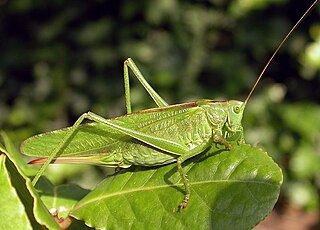
The Tettigoniinae are a subfamily of bush crickets or katydids, which contains hundreds of species in about twelve tribes.
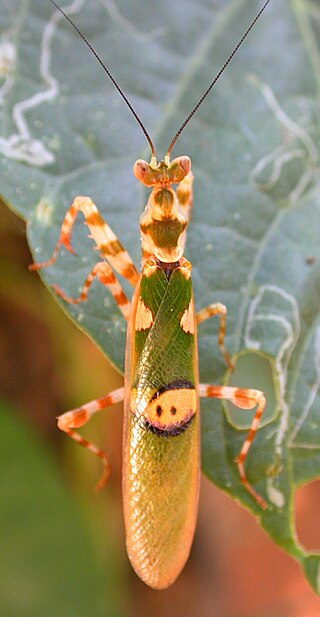
Creobroter is a genus of flower mantises in the tribe Hymenopodini; species are concentrated in Asia. The name comes from the Greek kreo-, meaning "flesh") and broter" meaning "eating", therefore, "flesh-eating", an apt name for a predatory insect. Both sexes have long wings and are capable fliers. Full-grown males are about 3 to 4 cm in length; females are about 4 to 5 cm.

Chthoniidae is a family of pseudoscorpions within the superfamily Chthonioidea. The family contains more than 600 species in about 30 genera. Fossil species are known from Baltic, Dominican, and Burmese amber. Chthoniidae now includes the former families Tridenchthoniidae, and Lechytiidae which has been demoted to subfamilies.

Rhombodera is a genus of praying mantises native to Asia and possessing common names such as shield mantis, hood mantis, and leaf mantis because of their extended, leaf-like thoraxes.
Astyliasula major is a species of praying mantis in the family Hymenopodidae.
Compsaditha is a genus of pseudoscorpions in the family Chthoniidae. There are about 12 described species in Compsaditha.
Ditha is a genus of pseudoscorpions in the family Chthoniidae. There are about 14 described species in Ditha.
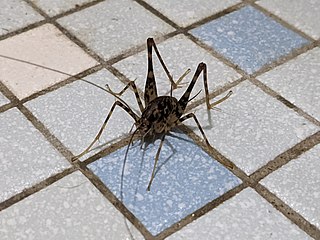
Diestrammena is a 'camel' or 'cave-cricket' genus in the family Rhaphidophoridae. Species in the genus are native to Asia, including Japan.
Dinocheirus is a genus of pseudoscorpions in the family Chernetidae.
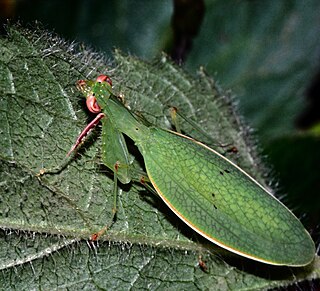
The Nanomantidae are a new (2019) family of praying mantises, based on the type genus Nanomantis. As part of a major revision of mantid taxonomy, genera and tribes have been moved here, substantially replacing the old family Iridopterygidae.
The Chroicopteridae are a family of praying mantids, based on the type genus Chroicoptera. The name is derived from first use, for subfamily Chroicopterinae, by Giglio-Tos and it has been revived as part of a major revision of mantid taxonomy. Some genera have also been moved here from the tribe Rivetinini, with others placed elsewhere including the subfamily Miomantinae.
Echinosoma is a genus of earwigs in the family Pygidicranidae, erected by Audinet-Serville in 1838.

Balta is a genus of cockroaches in the sub family Pseudophyllodromiinae. Found in Asia, Africa, Australia and Oceania. The genus was created in 1893 by Johann Tepper.
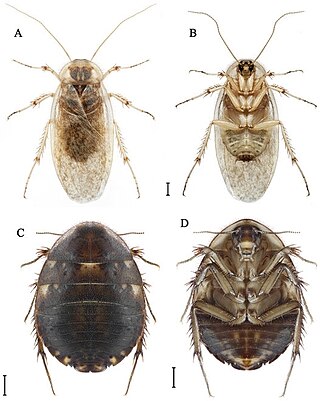
Hemelytroblatta is a genus of mostly Palaearctic cockroaches, in the subfamily Corydiinae, erected by Lucien Chopard in 1929. Species are distributed mostly in: North Africa, eastern Mediterranean countries through to central Asia; the type species, Hemelytroblatta cypria is found only on Cyprus.
Austrochthonius is a genus of pseudoscorpions in the family Chthoniidae. It was described in 1929 by American arachnologist Joseph Conrad Chamberlin.











